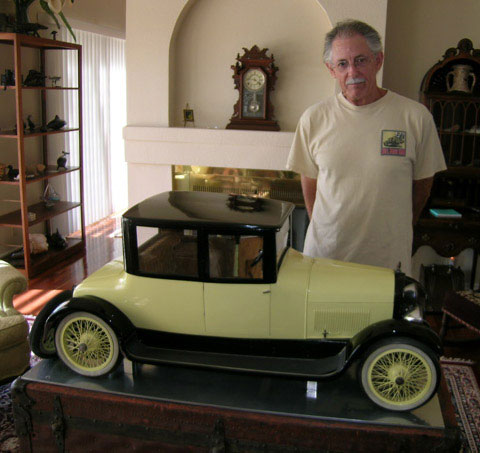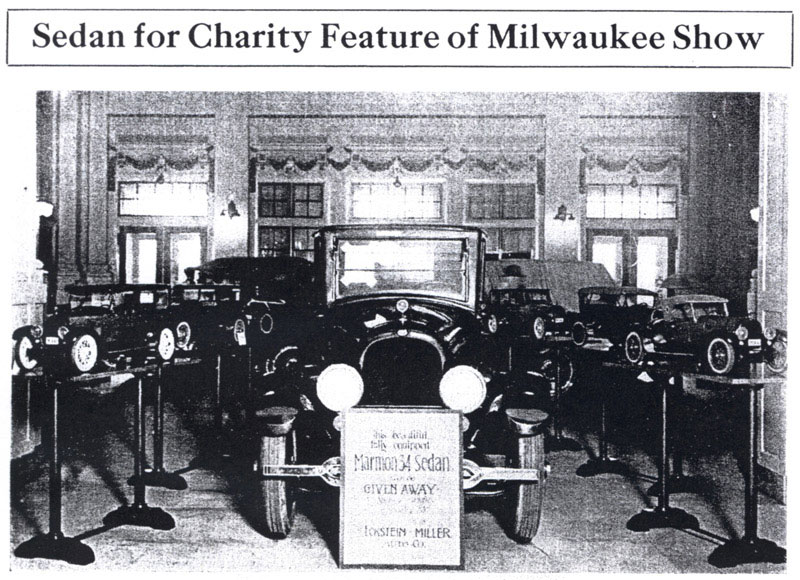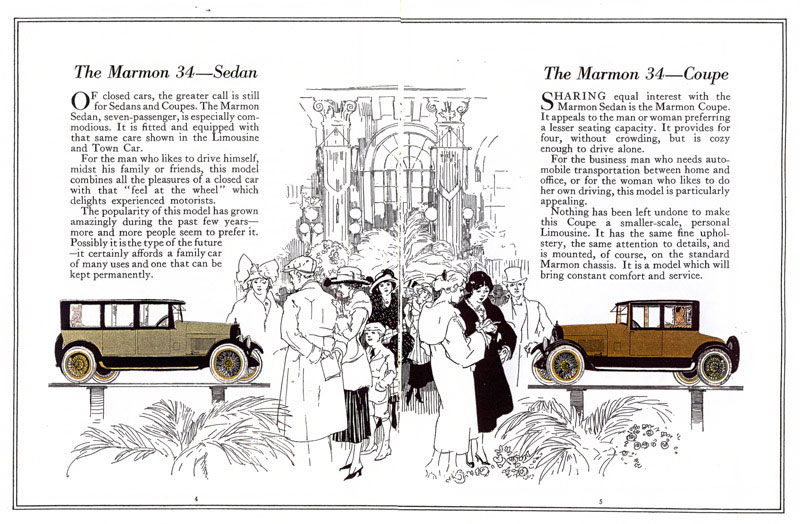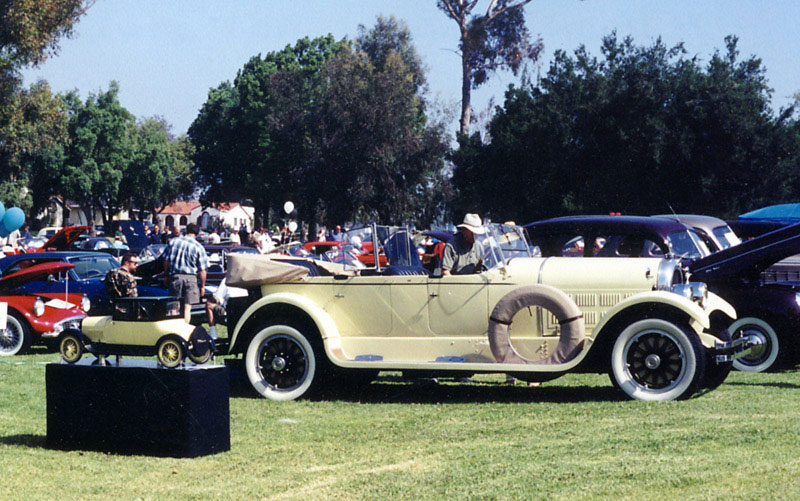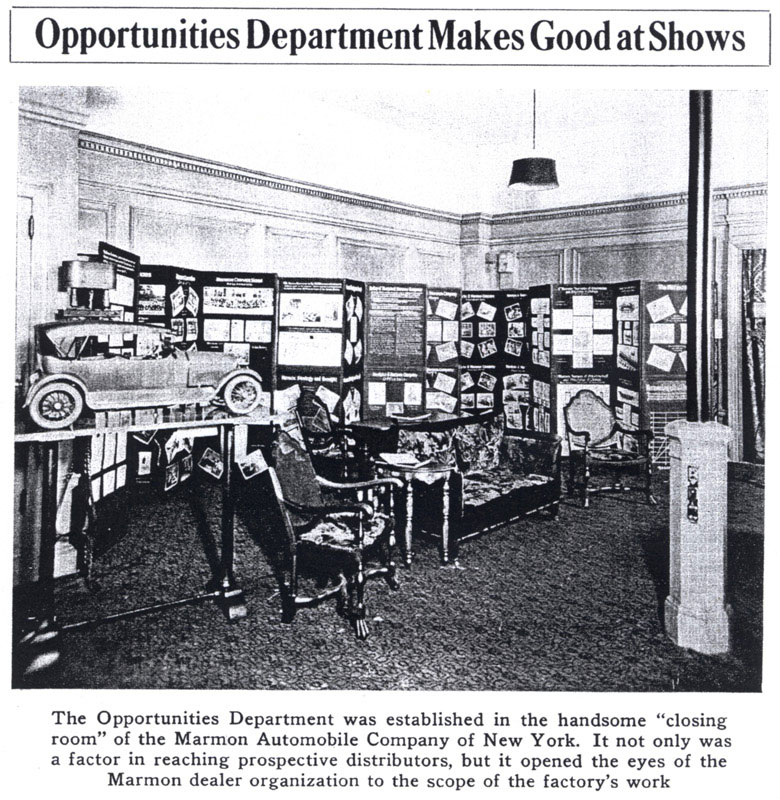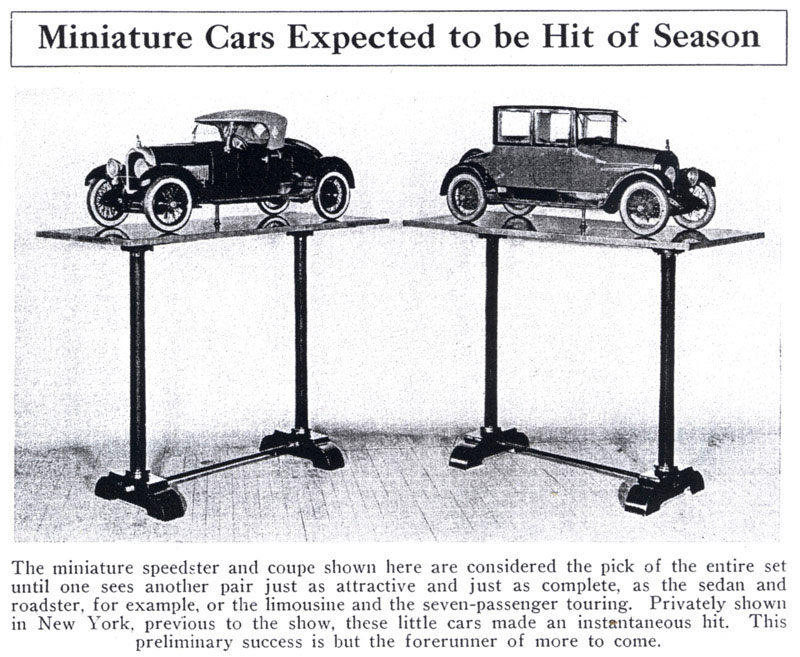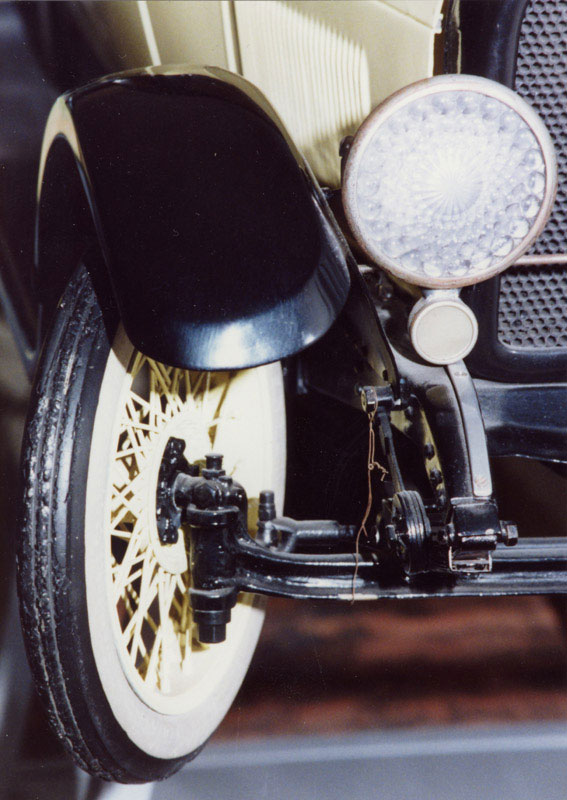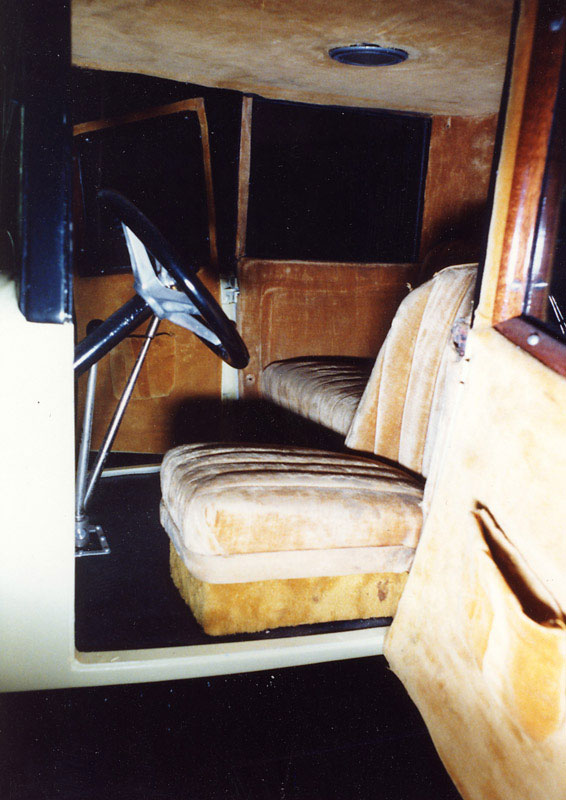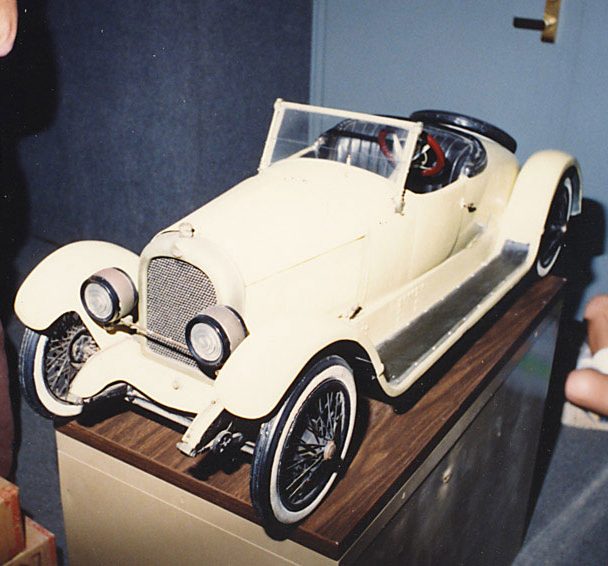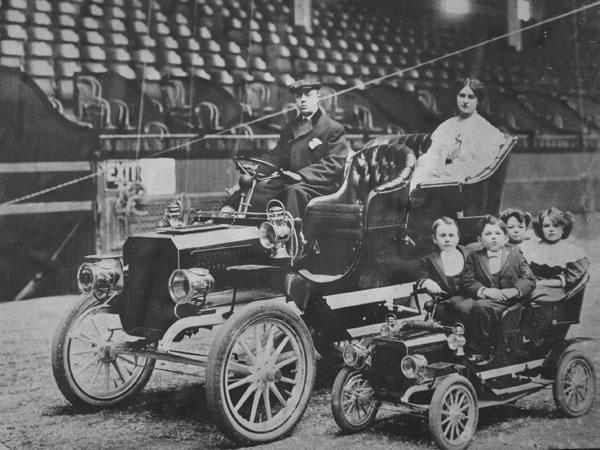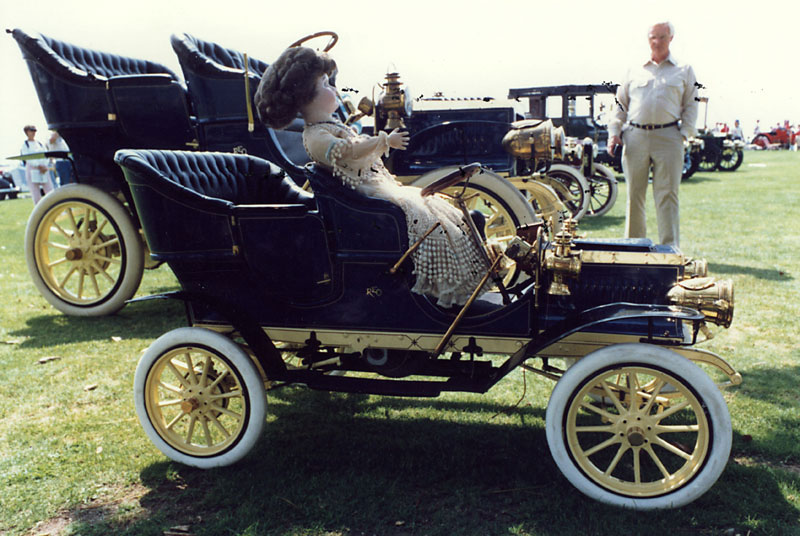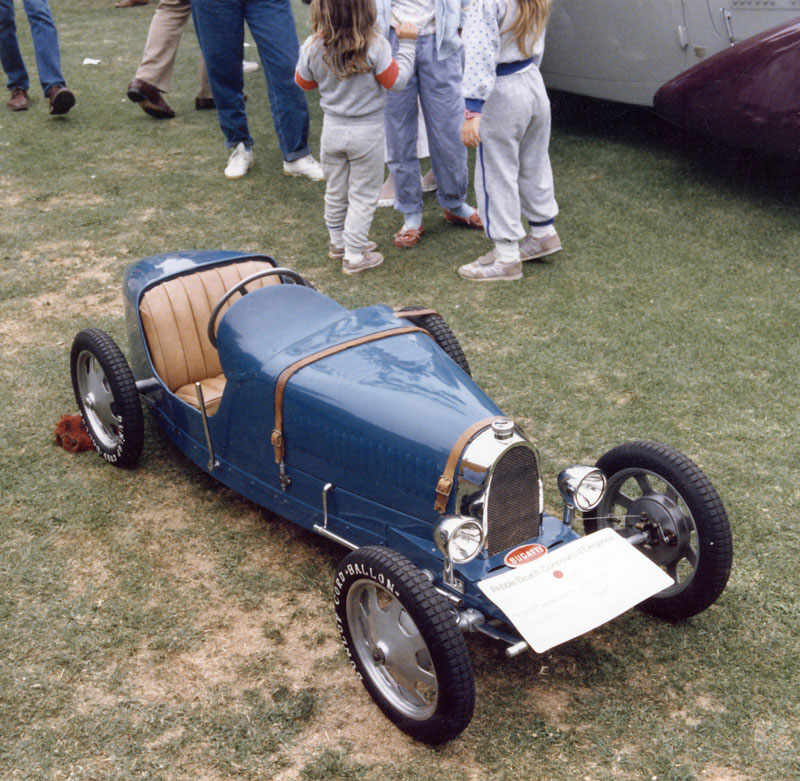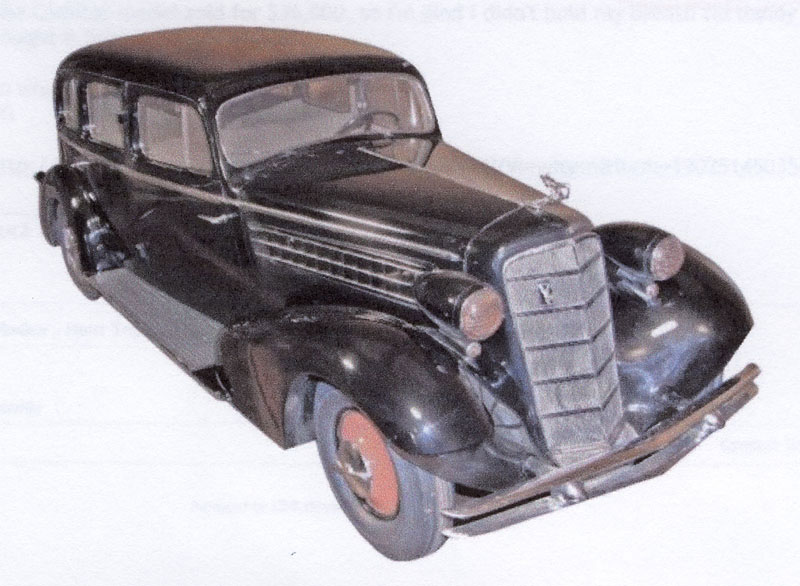Miniature Show Cars Built by Craftsmen in the Early Auto Industry
This miniature 1921 Marmon 34 Coupe was tracked down in the 1970’s by former Road &Track magazine publisher John R. Bond. The car now belongs to Mr. Bond’s nephew, Paul Bundy, shown here with the model. Of the remaining two Marmon models, this is the only one that has been restored. (Photo courtesy of Paul Bundy.)
Introduction
This craftsman article is a little different from most of the other pages in our archive. That’s mainly because the models featured on this page were made by unknown artisans working for early auto manufacturers. Some companies, like Bugatti, have made miniature replicas of their cars to sell to wealthy clients, but miniature cars served a more practical purpose at one point in automotive history. In the 1920’s, auto shows were becoming a popular way to show off the styling and features of a product line to the public. However, they were not the huge events that you might see today, which are typically held in giant convention centers. In some cases, companies were only allotted enough room in their booth to fit two full-size cars. Luxury cars in those days were also quite large in comparison to more modern ones.
All of this presented auto manufacturers with a challenge: how would they show all of their various options and products to the public? One solution was to build 1/4 scale models that were made to look exactly like the full-size production cars.
At the 1921 Milwaukee Auto Show, the prized full-size Marmon Sedan and six miniature Marmons were the center of attention. The two joint holders of the winning ticket took possession of the Marmon Sedan given away by the Eckstein-Miller Auto Co. In exchange for donating the car, Mr. Eckstein stipulated that 15% of the receipts from the show, or a minimum of $7,500 be divided among three Milwaukee charities. The show was a huge success as a promotion.
Honoring Unknown Craftsmen
Ultimately, we have decided to include these cars here even though we cannot identify any of the individual craftsmen who built them. They were true craftsmen nonetheless, and their work deserves to be represented. These builders had access to the original factory plans, materials, and techniques. The companies also employed a host of talented pattern makers back when many parts on cars were cast rather than stamped. It may also have been a situation where the apprentice workers in the shop were given this task to test and improve their skills.
This process may have been much like apprentice gunsmiths making miniature firearms before they could attain “master” status. These craftsmen were responsible for turning out model cars that would be so attractive that they inspired a customer to order the full-size version. A painstaking attention to detail was needed to replicate all of the fine details at scale. Of course, this would not be practical today, but skilled labor was cheaper and more plentiful back then.
This two-seat Marmon Speedster model is now hidden away in a back room at the Los Angeles County Museum of Natural History. The model car has only been viewed and photographed by a handful of people. (Photo courtesy of Paul Bundy.)
Now, we know of several such models that have survived the past century; however, most of them did not stand the test of time. Paul Bundy was lucky enough to inherit one of the classic model cars, and has gathered quite a bit of information about the relic. Paul owns a 1/4 scale Marmon model that was acquired back in the 1970’s by his uncle, John R. Bond.
Mr. Bond was the longtime publisher of Road & Track magazine. Paul’s story is published below as a salute to the unknown but talented industrial model makers of the past. His research on the subject helps to lend insight into a unique time in model making and automotive history.
This photo was taken in 1999 at a show at the Muckenthaler Art Museum in Orange, CA. It features a full-size Marmon 7-passenger Touring Car along with the 1/4 scale Coupe.
The Story of the Miniature Marmons
By Paul Bundy
“Replica Marmons Attract the Crowds.” Those were the headlines in newspapers and trade magazines throughout the east and the mid-west in 1921. The cause of this excitement was six 1/4 scale replicas of the Marmon body styles available for the 1921 season.
The Marmon Motorcar Company built cars from 1903-1933. The Marmon Wasp won the first Indianapolis 500 in 1911. A 1921 Marmon 34 cost $2,700, while a 1921 Ford Model T cost $370. In 1932, a Marmon 16, with its 16-cylinder engine, cost the same as a Duesenberg.
Auto expos of the era, including those in Chicago, Indianapolis, Toledo, Detroit, and New York had space for only two regular cars in each booth.
So, Marmon built exact 1/4 scale replicas of their 1921 lineup of eight different body styles. These were built by the company’s pattern department apprentices. According to the Marmon Post, the company newsletter, two replicas of each body were built for a total of sixteen.
However, a mystery surrounds the number of miniatures built. Only six show in photos of the time, and they are always the same six. The builders possibly ran out of time and couldn’t complete all sixteen.
The caption in this photo from the Marmon Post reads, “The Opportunities Department was established in the handsome ‘closing room’ of the Marmon Automobile Company of New York. It not only was a factor in reaching prospective distributors, but it opened the eyes of the Marmon dealer organization to the scope of the factory’s work.”
Shown here are the miniature Marmon Speedster and the Coupe, which is now displayed in restored condition. These cars were privately viewed before the show in New York and were an instant hit. These are two of the three remaining miniatures out of the original six (although accounts at the time state that as many as 16 were built).
For more than fifty years, only one car—the 2-seat Speedster in the Los Angeles County Museum of Natural History—was known to have survived. In 1977, my uncle, John R. bond of Road & Track magazine, after a 20-year search, found a second survivor, the Coupe, which I now have. Amazingly, in 2007, Ron Barnett, editor of the Marmon News received a call from an auctioneer in Vermont asking about a Marmon model. It turned out to be the Town Car, and Ron was able to acquire the car. Ron passed away in December, 2008.
The miniatures are exacting in detail, especially considering the era. Each model is bolted together using scale nuts, bolts and screws. The bodies are cast aluminum like the regular cars, with opening doors and working latches. The frame and cross-members are riveted. Closed car windshields can open. Interiors of the closed cars were silk, and open cars were leather. Drinking straws formed over a piece of hexagonal steel, cut to length, and glued together made up the radiators.
The dashboard is complete with 1/4 scale photographs of the instruments put into 1/4 scale bezels. All of the switches and controls are there, including the motometer. Tires were made specially for the cars by Goodrich. The wheels are brass and removable. The removable hubcaps and the grill badge were made by jewelers. These were the only parts not made in-house.
Originally, the headlights and dome lights worked, but they are no longer functional on the Coupe. The hood is removable and the latches work. The front and rear suspensions are fully operational with springs, shackles, and friction shocks. The front wheels steer but are not connected to the steering wheel. Marmons of that era only had rear brakes. They are of the external contracting type and are fully detailed, including cotter pins, springs, and linings. There are no engines or transmissions, although two 1/4 scale (non-operational) Marmon exhibition engines exist.
The wheelbase is 34 inches, the width is 17 inches, and the height is 18.5 inches. Overall length is 46 inches, and the Coupe weighs 85 pounds. The paint scheme on the replicas is the same as on their bigger brothers. I have the original shipping container. It is a specially built Hartman trunk.
The Town Car was sent to Lima, Peru for their Centennial Exhibition in July, 1921. The Sedan was sent to Mexico for their first auto show in April, 1921. The cars unaccounted for are the Sedan, possibly not returned from Mexico, the 7-Passenger Touring, the 4-Passenger Touring, the 4-Passenger Roadster (known as the “Cloverleaf”), and the Limousine. Considering the intended purpose of these replicas, it is remarkable that three have survived.
—Paul Bundy
Although the 1/4 scale Marmon convertible Speedster has been in the possession of the LA County Historical Society for many years, very few people have had the opportunity to see and photograph it. (Photo courtesy of Paul Bundy.)
A “Mama” and “Baby” 1906 REO
In 1906, the REO Motor Car Company built the first miniature gas powered car known to exist. Predating Marmon by almost two decades, the REO miniature was built as an exact model of their full-size offering for that year as a promotional idea. It was unveiled at the 1906 International Auto Show in New York.
The model car then toured the country with showings at dealerships and fairs to much acclaim. The miniature REO was even leased to the Ringling Bros. and Barnum & Bailey Circus for a while. It was used in their parades and shows, driven by small performers. The miniature car was lost and found twice over the years, and finally purchased by automotive designer Dick Teague.
In 1980, it was reunited with the full-size, identically painted “Mama” REO car. Both cars have toured the country was a pair ever since, appearing at many auto shows and exhibitions.
In 2008, the car was sold at auction and purchased by Peter and Debbie Stephens, the great-granddaughter of Ransom Eli Olds. The model now resides at the R.E. Olds Transportation Museum in Lansing, Michigan, returning the car to its original roots. Read the museum’s short article on the miniature car, along with some extra photos.
An old promotional photo of the 1906 “Mama” and “Baby” REO cars, with appropriately sized passengers. (Photo courtesy of the R.E. Olds Transportation Museum.)
Other Miniature Promotional Cars
Along with the aforementioned examples, some other companies also made miniature cars that were separate from the major auto manufacturers. These miniatures were typically electric or gas powered, very detailed, and were not intended to be pedal cars or toys. They were mostly used by car dealers as promotional vehicles. The mid-1950’s and early ’60’s was a popular era for these types of tiny vehicles. Read a short article about junior promotional cars from Street Muscle magazine.
A 1/2 scale “Baby” Bugatti Type 52 is shown at the Pebble Beach Concours. The miniature Bugatti was actually built at the factory and powered by an electric motor. It was designed for children from ages 5 to 8. The original “Baby” Type 52 was built for Ettore Bugatti’s second son, Roland. It was shown at the 1927 Milan Automobile Show. The wheelbase of the model is about 1.3 meters.
This 1934 V-12 Series 370D Cadillac Fleetwood sedan sold on eBay for $36,000. It’s another example of a 1/4 scale factory show car, and it was speculated to have been produced at the GM “Art and Color” studio. This studio was responsible for designing and building show cars. The auction didn’t note whether the scale Cadillac was powered or how detailed the interior was. The model is almost five feet long.
View more photos of some of the impressive miniature cars built by various auto companies.

